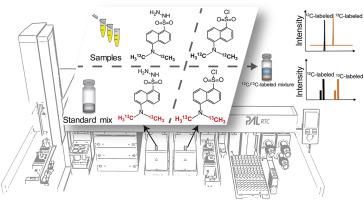当前位置:
X-MOL 学术
›
Anal. Chim. Acta
›
论文详情
Our official English website, www.x-mol.net, welcomes your
feedback! (Note: you will need to create a separate account there.)
Automated parallel derivatization of metabolites with SWATH-MS data acquisition for qualitative and quantitative analysis
Analytica Chimica Acta ( IF 5.7 ) Pub Date : 2020-08-01 , DOI: 10.1016/j.aca.2020.06.030 Maria Fernanda Cifuentes Girard 1 , David Ruskic 1 , Günter Böhm 2 , Renzo Picenoni 2 , Gérard Hopfgartner 1
Analytica Chimica Acta ( IF 5.7 ) Pub Date : 2020-08-01 , DOI: 10.1016/j.aca.2020.06.030 Maria Fernanda Cifuentes Girard 1 , David Ruskic 1 , Günter Böhm 2 , Renzo Picenoni 2 , Gérard Hopfgartner 1
Affiliation

|
For metabolite profiling chemical derivatization has been used to improve MS sensitivity and LC retention. However, for multi-analytes quantification, the number of commercially available isotopically labelled internal standards is limited. Besides, there is no single workflow which can provide large-scale metabolomics coverage in particular for polar metabolites. To overcome these limitations and to improve reproducibility a fully automated dual derivatization approach was developed. Differential Isotope Labeling (DIL) was adopted by derivatizing carbonyl, amino and phenol metabolites with two isotopic forms. Urine samples were derivatized with 12C-dansyl chloride (DnsCl) and 12C-dansylhydrazine (DnsHz). Suitable quantification standards were generated by derivatized 40 standards including amino acids, sex hormones and other highly polar metabolites with labelled 13C2-dansyl chloride and 13C2-dansylhydrazine. The derivatization of the standards and the urine sample was performed using a PAL RTC autosampler in-line to column-switching LC-HRMS analysis with data independent acquisition (SWATH-MS). The parallel reactions were completed in 15 min inside of two agitators at different conditions overlapping with the LC-MS analysis time which was of 25 min. The column switching setup is critical to remove the excess of reagents which can negatively affect the ionization efficiency and deteriorate the chromatographic performance. The combination of dual DIL with SWATH-MS acquisition enables post-identification of unknown metabolites and quantitation at precursor (MS1) and specific tag fragment (MS2) levels. The inter- and intra-batch accuracy and precision of the method fall in the range ±15% using single point calibration, and at MS1 or MS2 level providing full flexibility. The method was successfully applied to the analysis of human urine samples.
中文翻译:

使用 SWATH-MS 数据采集自动平行衍生代谢物进行定性和定量分析
对于代谢物分析,化学衍生化已被用于提高 MS 灵敏度和 LC 保留。然而,对于多分析物定量,市售同位素标记内标的数量是有限的。此外,没有单一的工作流程可以提供大规模代谢组学覆盖,尤其是极性代谢物。为了克服这些限制并提高重现性,开发了一种全自动双衍生方法。通过衍生具有两种同位素形式的羰基、氨基和苯酚代谢物,采用差分同位素标记 (DIL)。尿液样品用 12C-丹磺酰氯 (DnsCl) 和 12C-丹磺酰肼 (DnsHz) 衍生化。合适的定量标准品由衍生的 40 种标准品生成,包括氨基酸、性激素和其他具有标记的 13C2-丹磺酰氯和 13C2-丹磺酰肼的高极性代谢物。使用 PAL RTC 自动进样器在线进行标准品和尿样的衍生化,以进行数据独立采集 (SWATH-MS) 的色谱柱切换 LC-HRMS 分析。平行反应在两个搅拌器内在不同条件下在 15 分钟内完成,与 25 分钟的 LC-MS 分析时间重叠。色谱柱切换设置对于去除过量的试剂至关重要,这些试剂会对电离效率产生负面影响并降低色谱性能。双 DIL 与 SWATH-MS 采集相结合,可以在前体 (MS1) 和特定标签片段 (MS2) 水平上对未知代谢物进行后鉴定和定量。使用单点校准,该方法的批间和批内准确度和精密度在 ±15% 的范围内,并且在 MS1 或 MS2 级别提供完全的灵活性。该方法已成功应用于人体尿液样品的分析。
更新日期:2020-08-01
中文翻译:

使用 SWATH-MS 数据采集自动平行衍生代谢物进行定性和定量分析
对于代谢物分析,化学衍生化已被用于提高 MS 灵敏度和 LC 保留。然而,对于多分析物定量,市售同位素标记内标的数量是有限的。此外,没有单一的工作流程可以提供大规模代谢组学覆盖,尤其是极性代谢物。为了克服这些限制并提高重现性,开发了一种全自动双衍生方法。通过衍生具有两种同位素形式的羰基、氨基和苯酚代谢物,采用差分同位素标记 (DIL)。尿液样品用 12C-丹磺酰氯 (DnsCl) 和 12C-丹磺酰肼 (DnsHz) 衍生化。合适的定量标准品由衍生的 40 种标准品生成,包括氨基酸、性激素和其他具有标记的 13C2-丹磺酰氯和 13C2-丹磺酰肼的高极性代谢物。使用 PAL RTC 自动进样器在线进行标准品和尿样的衍生化,以进行数据独立采集 (SWATH-MS) 的色谱柱切换 LC-HRMS 分析。平行反应在两个搅拌器内在不同条件下在 15 分钟内完成,与 25 分钟的 LC-MS 分析时间重叠。色谱柱切换设置对于去除过量的试剂至关重要,这些试剂会对电离效率产生负面影响并降低色谱性能。双 DIL 与 SWATH-MS 采集相结合,可以在前体 (MS1) 和特定标签片段 (MS2) 水平上对未知代谢物进行后鉴定和定量。使用单点校准,该方法的批间和批内准确度和精密度在 ±15% 的范围内,并且在 MS1 或 MS2 级别提供完全的灵活性。该方法已成功应用于人体尿液样品的分析。











































 京公网安备 11010802027423号
京公网安备 11010802027423号